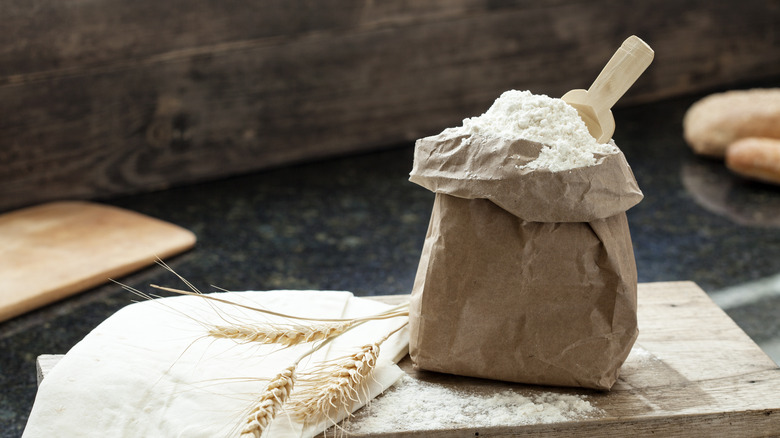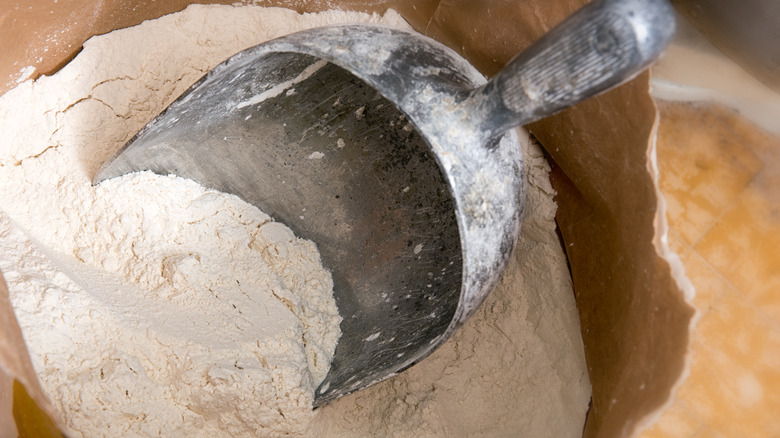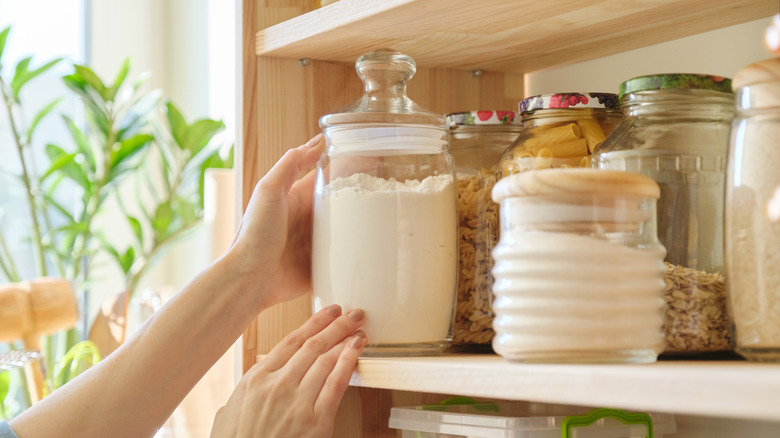Why You Should Never Store Open Bags Of Flour In Your Kitchen Pantry
There are certain foods most people know they have to store carefully. Obviously, people refrigerate dairy, most know a bag of chips will go stale if left open in the pantry, and most acknowledge that even heartier shelf-stable foods like spices will lose their luster in time. But many people tend to think of dry baking ingredients like flour as virtually invincible. In reality, flour is not one of those rare foods that truly don't go bad.
If you've ever been guilty of opening a bag of flour and leaving it that way in the pantry for months, you're not alone, but while the signs might not be obvious to the naked eye, storing flour like this is a no-no. Flour won't develop obvious signs of rot as quickly as other foods will — nor will you necessarily immediately taste that it's stale or losing its flavor. But just because that open bag of flour doesn't have any immediate visible signs of decay doesn't mean the quality isn't slowly deteriorating.
Keeping your flour properly stored in an air-tight container is essential to prevent the development of mold, keep it from getting clumpy or wet, and ward off pests like weevils and moths, which can be attracted to dry goods. No matter the type of flour — though whole grain varieties are even more susceptible to decay and spoilage — it should never be kept open in the pantry, which invites in air, moisture, and sunlight — accelerants for deterioration.
Yes, your flour can go bad
Your fridge probably gets a weekly — or every other week maybe — clean out. You're routinely tossing bread with blooms of mold and mildew. But it's probably far past time to toss your flour if it's been hanging out in the back of your pantry for who knows how long. But despite its seeming insusceptibility to going bad, flour does indeed spoil, and this process is significantly hastened when it's exposed to oxygen, sunlight, and moisture — all of which can create chemical reactions in the flour as air and oxygen, especially, interact with the fat content of the flour grain. This interaction is responsible for spoilage.
Once you've ripped open the original paper bag your dry goods came in, even if you attempt to fold down or reseal with a bag clip or the like, these three elements are invited to creep in. Even when bags are left open in a dry, cool pantry, this exposure invites in moisture which causes clumpiness (flour should always maintain its light, siftable texture), and even pests. Flour that's gone bad, which can occur in as little as three months if left open in its original bag, often develops an off, musty scent — which has been compared to Play-Doh! Trust your nose and your eyes and toss, when in doubt.
Keep flour in airtight containers for freshness
You don't need to be overly precious about your flour storage — a simple mason jar with a well-fitting lid does the trick, as well as any other food storage canister or even a large Ziploc bag. So long as you keep your flour well sealed up and away from sunlight, versus in the paper bag it was sold in, you're well on your way to preventing the vast majority of potential spoilage issues and making your baking ingredient last as long as it should. Bags will come with an expiration date, but many food pros suggest treating this as a guideline rather than a hard rule, and looking (and sniffing) for any signs of decay before immediately tossing on the exact date.
If you really want to extend the lifespan of flour to its maximum, and/or you know you don't use much and will go through your supply slowly, keep it in the refrigerator or better yet, the freezer. Much like other shelf-stable dry ingredients — coffee, even nuts and seeds — keeping flour chilled means it's safe from creepy crawly pests and halts the development of mold or changes to texture, taste, and smell. Meaning when that next late-night cookie craving strikes or you have the urge for Saturday morning pancakes, your flour will be perfectly fresh and ready to fuel your baking projects.


